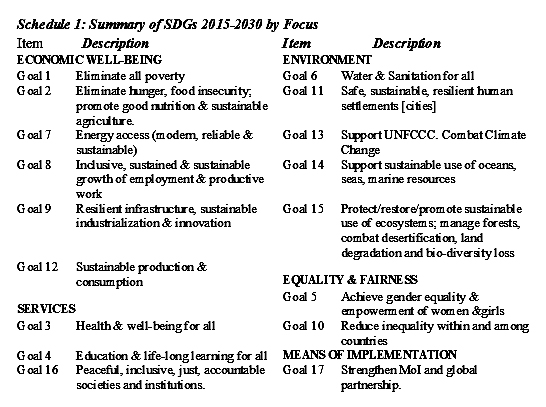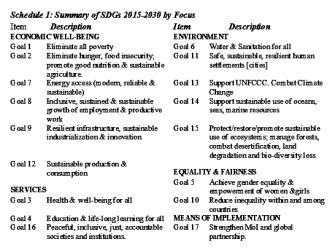Introduction
Last week’s column briefly reflected on the ongoing transitioning from the present era of the Millennium Development Goals (MDGs) for global development (2010-2015), which expires this year to the upcoming Post-2015 Development Agenda that is presently being forged by the global community. Guyana is undoubtedly, an earnest partner in these  efforts. The proposed Post-2015 Agenda has four major components; namely, a Declaration to be agreed to by all member states of the United Nations (including Guyana). This will state their common vision, purpose, and the principles driving the agenda; an agreed set of Sustainable Development Goals (SDGs) to be achieved over the period 2015-2030; the Means of Implementation (MoI) for these goals through a global partnership; and, finally, the modalities for monitoring and reviewing performances of countries (again, including Guyana) in regard to their attainment of these goals and their related targets.
efforts. The proposed Post-2015 Agenda has four major components; namely, a Declaration to be agreed to by all member states of the United Nations (including Guyana). This will state their common vision, purpose, and the principles driving the agenda; an agreed set of Sustainable Development Goals (SDGs) to be achieved over the period 2015-2030; the Means of Implementation (MoI) for these goals through a global partnership; and, finally, the modalities for monitoring and reviewing performances of countries (again, including Guyana) in regard to their attainment of these goals and their related targets.
Follow-up
The upcoming September United Nations summit is expected to reach agreement on the SDGs, their targets, and the agreed modalities for monitoring and reviewing their implementation. This activity will be followed by the “follow-up” 21st meeting of the Conference of Parties to the United Nations Conference on Sustainable Development (UNCSD) held in 2012. This follow-up is scheduled to be held in France in December of this year. This conforms to the description given last week that, the Post-2015 Development Agenda represents the convergence of two separate processes; namely, 1) the follow-up to the MDGs process initiated at the start of the millennium (2000) and 2) the follow-up to the UNCSD, 2012 process. As readers know the latter has focused on global efforts to address climate change, as well as environmental destruction and degradation.
The SDGs
Beginning this week, this series of columns will consider in somewhat greater detail the SDGs. Fortunately, the inter-governmental group that has been preparing the Outcome Document for the September UN Summit has just completed its work, entitled: Transforming our World 2030 – a New Agenda for Global Action. The document establishes 17 SDGs and 169 defined targets.
Clearly I cannot attempt to discuss so many goals and targets in any depth in a Sunday column series. I shall therefore, have to be severely selective. Nonetheless, for the convenience of readers I provide in the schedule below, a highly condensed summary of the 17 goals. Additionally, I have attempted to classify these into five broad categories; namely: economic well-being, services, environment, equality and fairness, and means of implementation. These categories are not definitive; they merely seek to classify the goals for readers’ convenience, as a serial listing of 17 goals might be confusing.
Evaluation
Beginning today and continuing in next week’s column I shall attempt to evaluate these goals and their related targets. However, no attempt will be made to reproduce the targets in their entirety; they are far too many (169 target indicators). Despite this it is important for readers to recall the observation, which I made last week, to the effect that the SDGs process had started with an evaluation of the previous MDGs process. This was done in order to identify useful lessons that could be learnt.
As was also indicated last week, one of the major weaknesses observed in the MDG process had been that, the formulation of its goals and targets was too reliant on “experts”, whether in small groups or as individuals. As a result the SDGs process strove to ensure that it was located in an intergovernmental process. This was agreed upon by the 193 member states of the United Nations, and indeed will be finally voted on, later this year at the summit.
Another observed weakness of the MDG process is that it placed far too much reliance on official development assistance (ODA) to be provided by rich countries to poor ones. This was seen as the driving element of investment in the economic growth of poor countries. As we know these agreed targeted transfers of ODA have not been met. And, more importantly, it has come to be recognized by the international development community that the sustained growth and development of poor countries depends critically on their mobilization of domestic resources, in particular through more transparent, efficient and just tax regimes, as well as transnational companies/ external investors’ contractual relations with governments of poor states.
Finally, given our area of special concern in this series of columns (the recovery of stolen public assets), the impediments to sustainable development posed by corruption in all its forms has been recognized and steps taken to guard against this in the SDGs process.
Next week I shall continue from this observation.










